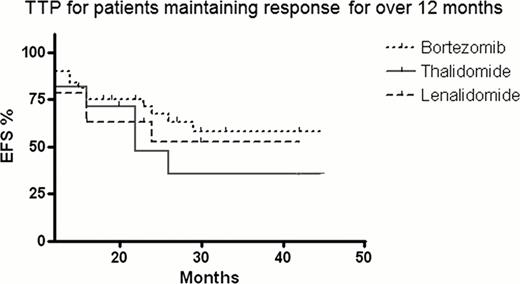Abstract
Abstract 1860
AL amyloidosis is a plasma cell dyscrasia, associated with low survival rates, especially in patients with cardiac involvement. Treatment includes chemotherapy, mostly melphalan, and steroids, aiming to suppress amyloidogenic light chain production. Hematological response (HR) is correlated with improved survival and restoration of organ function. Introduction of novel agents such as Thalidomide, Lenalidomide and Bortezomib, over the last decade was suggested to improve patients' outcome. However, these encouraging data are mainly coming from small prospective studies affected by potential selection bias due to the exclusion of patients with poor prognosis. “Real-life” reports are required to assess the efficacy of these new treatments in a non-selected patient population.
The aims of this retrospective observational study was to evaluate the “real-life” response of patients with systemic AL amyloidosisto novel agents, regardless of age or disease severity.
Data of patients treated with novel agents at 10 different Israeli hospitals were analyzed. Newly diagnosed and relapsing systemic AL amyloidosispatients were eligible, if they received at least one cycle of novel agent based therapy. Specific regimens and doses were at the discretion of treating physicians.
89 patients treated with 114 cycles of novel agent regimens, were reported. Median age at presentation was 66 years. At baseline evaluation, the median NTproBNP and troponin were 1450 and 0.068, respectively. 85% of patients had renal or cardiac or both organ involvements (34%) at presentations. 41% had > 2 organs involved. Treatment protocols included: Thalidomide-steroid-based therapy (n=19, comprising 10 who have also received alkylator chemotherapy); Lenalidomide-steroid based therapy (n=26, 13 with alkylator chemotherapy) and Bortezomib-steroid based therapy (n=68, 43 with alkylator chemotherapy). Treatment with Thalidomide-based regimens resulted in an overall response rate (ORR) of 73%, including 26% ≥VGPRs. Treatment with Lenalidomide-based regimens resulted in an ORR of 63%, including 36% ≥VGPRs. Yet, only 5 of 26 patients received this agent as first-line therapy. Treatment with Bortezomib-based regimens resulted in an ORR of 80%, including 55% ≥VGPRs. In general, treatment of newly diagnosed patients yielded better responses in all the arms and was most prevalent in the Bortezomib group (44 of 68 patients). However, it is noteworthy that about 30% of patients experienced grade 3 adverse events (heart and renal failure, and severe infections), mostly following Bortezomib and Lenalidomidebased regimens.
At a median follow up of 12 months (range1–87 months), the overall survival was 52% (35%, 65% and 68% respectively for the three treatment groups, p= n.s.). Interestingly, censoring patients without progression for more than 12 months (with a median follow up of 20 months) revealed that 2 of 11 and 5 of 13 in the Thalidomide and Lenalidomide treated patients maintained their responses, compared with 31 of 44 patients treated with Bortezomib based regimens (Figure 1).
Treatment with novel agents, especially Bortezomib-based regimens, may result in long-term responses in a substantial number of newly diagnosed and relapsing patients with AL amyloidosis. This may be translated into a better overall survival of responding patients. Physicians caring for these patients should be aware of potential treatment-related toxicities
No relevant conflicts of interest to declare.
Author notes
Asterisk with author names denotes non-ASH members.


This feature is available to Subscribers Only
Sign In or Create an Account Close Modal